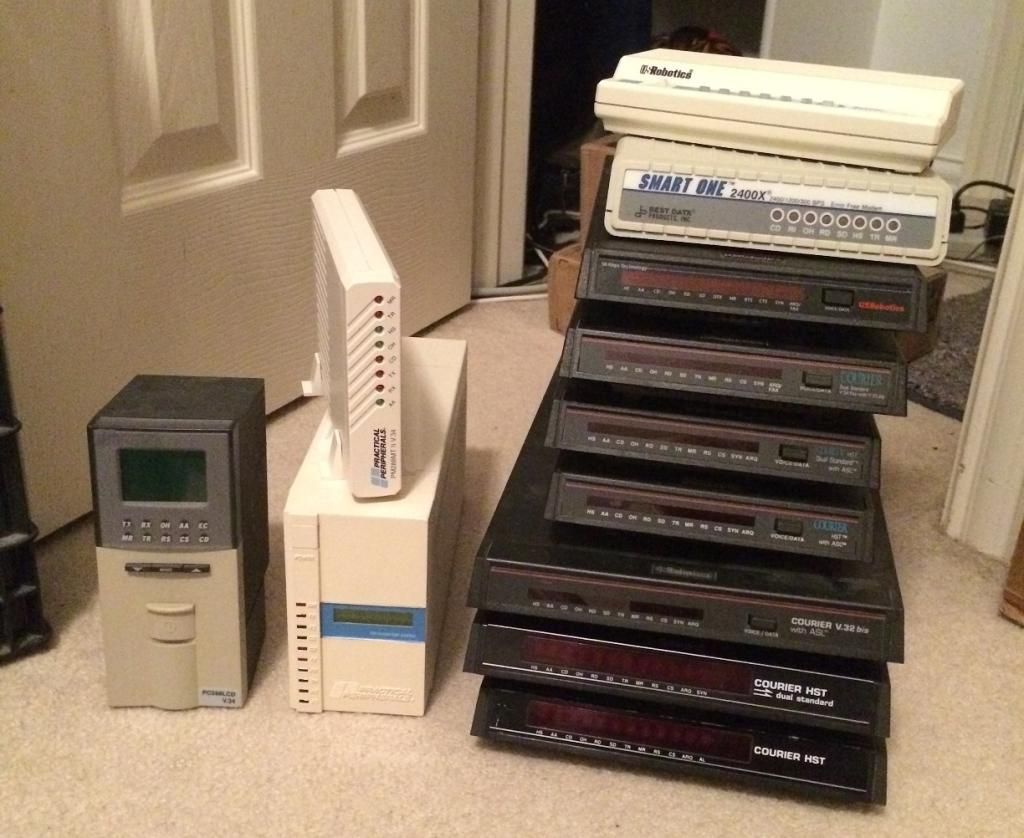First post, by QBiN
- Rank
- Oldbie
It just struck me while I was going through some parts... that we, generally as a retro community, seem to ignore one category of retro hardware. Is it simply because, in and of itself, this gear provides current day utility approaching zero? I'm talking about the modem, of course. Interestingly, the NIC of years past and the modem have undergone a complete role reversal over the decades.
If you had a NIC during the 80's, 90's, and even early 2000's, you were in the minority. Unless you worked at a company that was an early adopter of networking or a university that was an early adopter, you may have only had a NIC to play some of the earliest LAN games over IPX. Far more people had modems, and they were indispensable for getting "online", checking email from FidoNET, getting to your "shell" account, or downloading drivers for your hardware from the manufacturer's BBS. There was also Prodigy, Compuserv, and AOL (among a slew of others) dedicated services that were around even before SLIP/PPP and dial-up ISP's became popular. The BBS's of that era were really the fore-runner to internet forums like this one.
As modems got faster in the 286/386/486 era... There was one upgrade that we don't usually talk about here, but most from that time will remember: the 16550 UART chip. Most early PC's of this era came with the National Semiconductor 8250 UART chip. This is the chip that took parallel data (bytes) that your software generated and converted it to a RS-232 serial stream and provided appropriate control lines to send this data to a remote computer via modem or null-modem cable. The 8250 only allowed effective baud rates of up to 9600. Later, some of these early x86 PC's started to come with the 16450 UART. This later chip allowed higher speeds, but didn't have large enough buffers to ensure you didn't lose data if your PC was momentarily busy when the serial port received data and couldn't service the serial interrupt in time. This isn't meant to be a technical deep-dive into UART's. So long story, short... When compression and speeds faster than 9600 started showing up, everyone scrambled to ensure they had a 16550A UART. This was the chip that allowed COM port speeds up to 115,200 and beyond with adequate buffers to help slower PC's keep up. It was a game-changer.
Folks like you and me now started looking at ensuring our Multi-IO cards were 16550-spec, or checking to see if the UART's on our built in serial ports were socketed. Many older PC/XT's/AT's could be upgraded just by swapping out the 40pin UART DIP chip. By the time Multi-IO was being integrated into motherboards, 16550A (or compatible) UART's were a de-facto standard. All Multi-IO cards had a single integrated chip with all the multi-io functions and 16550's built-in. All internal modem cards came with them.
Today, even in our retro rigs, our serial ports see little use past a serial mouse in most cases (if that). The NIC's we may have barely used back then are now prized as getting these older machines on the LAN with MS Lan Manager, MS DOS Lan Clients, or (especially) WFW 3.11 are the more convenient method to move data around with SMF/CIFS windows file shares. Windows 9x and later makes this trivial.
I dare say the modem, that was once of immeasurable importance, is now the least regarded and valued of retro gear out there. Well... I still have many of my old ones. I used to run a multi-line BBS in Southern California... so perhaps I have too many still. I just can't bring myself to get rid of them.
Do any of you guys have good modem stories/memories?





